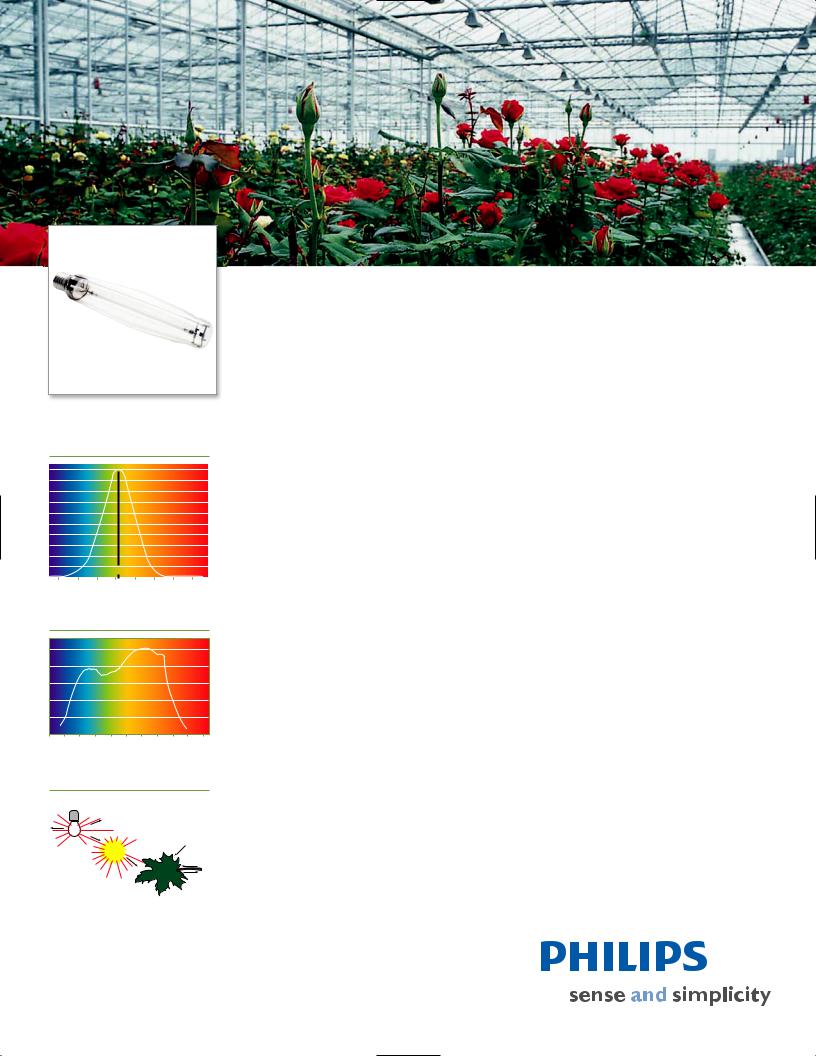Philips 14064-0, 40490-5, 40488-9, 40487-1, 31710-7 User Manual
...
Philips Horticulture Lamps
The role of light in the growth and development of plants.
Light sensitivity curve of the human eye
|
1.0 |
|
|
|
|
|
|
|
|
|
0.9 |
|
|
|
|
|
|
|
|
SensitivityEye |
0.8 |
|
|
|
|
|
|
|
|
0.5 |
|
|
|
|
|
|
|
|
|
|
0.7 |
|
|
|
|
|
|
|
|
|
0.6 |
|
|
|
|
|
|
|
|
Relative |
0.3 |
|
|
|
|
|
|
|
|
|
0.4 |
|
|
|
|
|
|
|
|
|
0.2 |
|
|
|
|
|
|
|
|
|
0.1 |
|
|
|
555 |
|
|
|
|
|
|
|
|
|
|
|
|
|
|
|
|
|
|
|
|
|
|
|
|
|
400 |
450 |
500 |
550 |
600 |
650 |
700 |
750 |
|
Wavelength (nm)
Light sensitivity curve of plants
Efficiency |
1.0 |
|
0.8 |
||
Quantum |
||
0.6 |
||
Relative |
0.4 |
|
0.2 |
||
|
||
|
0 |
300 |
400 |
500 |
600 |
700 |
800 |
Wavelength (nm)
Photosynthesis process
Light source as proton emitter
Light particles
or photons (= growth light)
|
Carbon |
Growth light |
dioxide |
|
Water |
Photosynthesis Glucose
Plant growth (photosynthesis) is not then determined by lux or energy, but by the photons from the blue to red (400–700 nm) part of the spectrum. This is called growth light!
For the human eye, light is the visible part of electromagnetic radiation. Most lighting products are developed for human application. For these purposes, the intensity of visible light is expressed in lux. Lux is a photometric unit and is based on the average sensitivity of the human eye.
The sensitivity is maximized at green/yellow (555nm) and declines towards longer (red) and shorter (blue) wavelengths.A lux meter is corrected for this specific eye sensitivity.
For horticulture, natural daylight (global radiation) is in most cases measured in terms of energy
(J or W) with a solar meter.This meter is generally positioned on top of the greenhouse.The value of global radiation is important for climate and humidity control in the greenhouse.
Growth Light
Plants have a completely different sensitivity for colors of light than the human eye. For plant growth, it is important to define light as small
light particles, also called photons or quantum. The energy content of photons is different depending on wavelength (color of light). For one W of energy, almost twice as many red photons can be produced compared to blue. In addition to this, plants are most efficient using the red part of the light and less efficient using the green and blue part. In fact, we are dealing with a plant sensitivity curve for growth light.
Micromol and PPF
Research, both at universities and applied research stations, has demonstrated that the rate of photosynthesis is determined by the amount of photons between 400–700 nm. In scientific terms, this growth light is called Photosynthetic Photon Flux (PPF) and is the only reliable measure to clarify if a light source is suitable for photosynthesis.The higher the PPF value per Watt, the more efficient the light source for plant growth.This is the reason why Philips specifies the PPF value in micromols per second (µmol/s) for all its light sources for horticultural use. Philips Green Power and Agrolite XT lamps are specially developed for maximum growth light and for this reason, are among the most efficient light sources available for horticulture.
